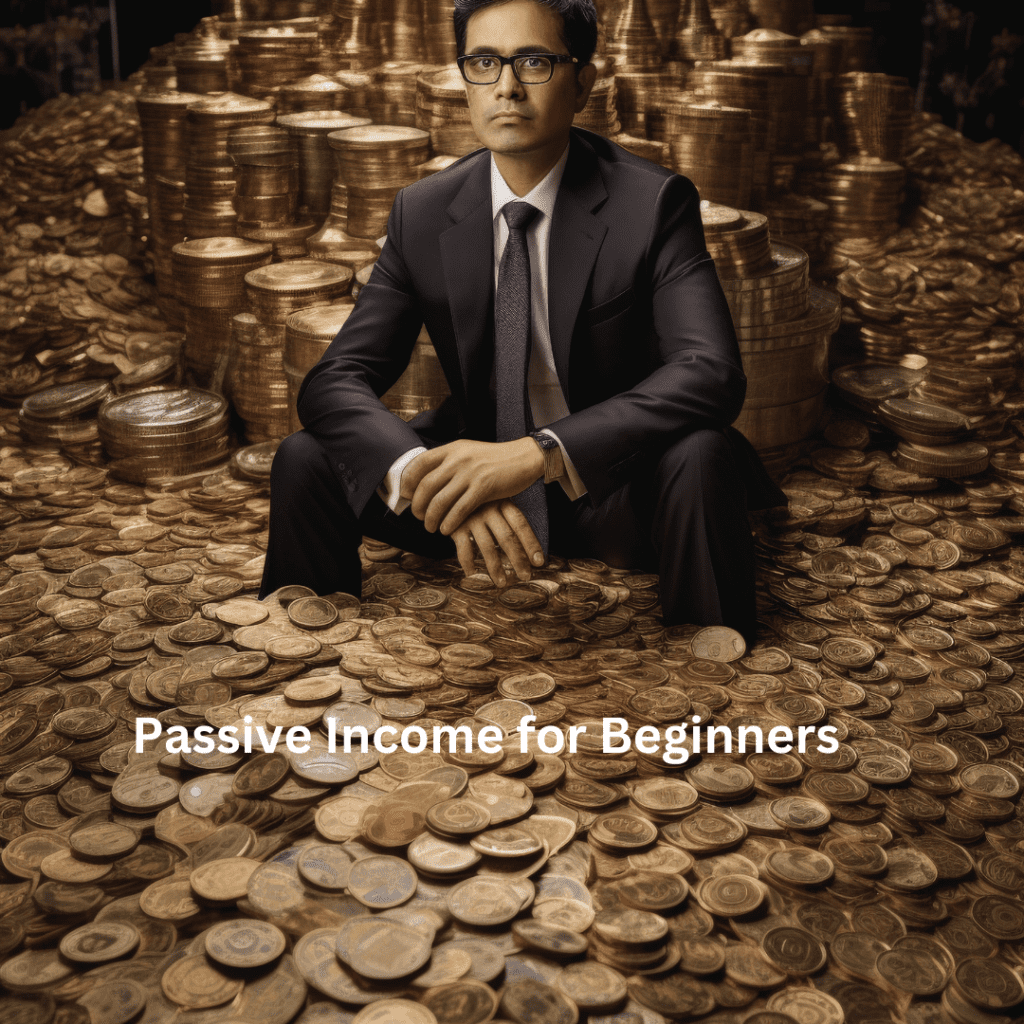Passive Income for Beginners: A Complete Guide to Getting Started
Passive income is an effective approach to create revenue without requiring active, day-to-day involvement. This makes it a tempting option for beginners who want to diversify their income streams and achieve financial independence. In this blog post, we will discuss what passive income is, how to start earning it, and how to succeed on your passive income path. What is Passive Income? Passive Income for Beginners Passive income for beginners refers to as money that requires little or no continuing effort to generate. Unlike a regular employment, which requires you to actively trade time for money, passive income allows you to make money even when you are not physically involved in the activity. Many people confuse passive income for something that involves no effort, but this is not totally accurate. Building passive revenue streams typically requires an initial input of time, money, or effort, but once established, they require no maintenance. Why Consider Passive Income? Passive income for beginners is an excellent approach for increasing regular income and eventually provide financial security. Passive income for beginners can provide flexibility, minimise financial dependence on a single job, and contribute to long-term prosperity. It enables you to create a safety net, providing you the opportunity to pursue personal goals or retire earlier than planned. Whether you want to pay off debt, save for a big purchase, or simply have extra money flowing in, passive income is an appealing and achievable objective with the right strategy. Types of Passive Income Streams There are several ways to begin making passive income for beginners, they must choose the best option based on their talents, interests, and available resources. The following are some of the most popular passive income streams for beginners. 1. Dividend Stocks Investing in dividend stocks is a great option for beginners to earn passive income. Dividend-paying stocks provide a percentage of the firm’s earnings to shareholders, ensuring a consistent income stream as long as the company is profitable. Beginners can begin by studying reputable dividend-paying companies with a track record of dividends. Dividends can be reinvested over time to help build your portfolio and income. Digital Products 2. Create and Sell Digital Products Creating and selling digital products, such as eBooks, courses, or software, is becoming an increasingly popular way for beginners to generate passive income. With sites like Gumroad, Teachable, and Udemy, it’s easier than ever to develop a product once and sell it several times with no ongoing effort. Digital products need initial effort, but once built, they can generate cash over time with minimal intervention. For beginners with a specialised talent or knowledge set, this is an excellent approach to begin earning passive money. 3. Affiliate Marketing Affiliate marketing is one of the most effective strategies for beginners to earn a passive income. This method entails promoting the products or services of other businesses while earning a percentage on sales made through your unique referral link. To begin affiliate marketing, you’ll need a platform (such as a blog, YouTube channel, or social network account) for sharing information promoting affiliate products. Amazon Associates, etc. are among the most popular affiliate programs. 4. Rent Out Your Assets Renting out assets such as your car, home, or even equipment is an easy way for beginners to start earning passive money with little effort. Platforms such as Airbnb, etc. make it simple to rent out stuff you don’t use. This allows you to produce passive income for beginners with minimal ongoing effort. To prevent legal complications, simply follow local rental rules and regulations. 5.Build a Niche Website Building a specialised website is another excellent way for beginners to earn passive income. A niche website focusses on a specific topic, attracts a targeted audience, and is monetised through advertising, affiliate marketing, or digital product sales. Once your website gets popularity and traffic, it can create passive money through ad networks like Google AdSense or affiliate programs like Amazon Associates. As a newbie, focus on providing high-quality content that adds value to your audience, and your site will eventually become a passive income machine. 6. Invest in a Business Investing in a business is a good option for beginners to make passive income, especially if they have the funds but lack the time to set up their own business. You can invest in a business as a silent partner or purchase stock in a flourishing company on the stock exchange. Beginners can earn passive income in the form of dividends or business profits by making wise investment decisions rather than managing day-to-day activities. 7. Real Estate Investments Real estate is one of the most well-known sources of passive income for beginners. Purchasing rental properties allows you to earn a consistent monthly income with no ongoing effort. Once you’ve established your properties, the key tasks are property administration, tenant communication, and maintenance, which are sometimes outsourced to property managers for a completely hands-off approach. In addition to direct property ownership, beginners can invest in real estate via Real Estate Investment Trusts (REITs), which allow you to participate in real estate portfolios without having to manage the properties yourself. Steps for generating passive income for beginners Steps to Building Passive Income Now that we’ve covered over different types of passive income for beginners, here are some steps you can take to begin developing your streams of Passive Income: 1. Identify your strengths and resources. Assess your talents, interests, and available funds to determine which passive income streams are most suitable for you. 2. Research and Planning: Passive income takes time to accumulate. To manage risk, research the type of income you want to pursue, make a plan, and start small. 3. Invest Time or Money: Many passive income options demand either time (for developing digital products or websites) or money (for investing in real estate or equities). Or some passive income sources
IUL 101: A Comprehensive Guide to Indexed Universal Life Insurance
Introduction to IUL Insurance Indexed Universal Life (IUL) insurance is a type of permanent life insurance that combines the benefit of payment received on the death along with the savings component. This savings component generates interest based on the performance of a specific stock market index, such as the S&P 500. An IUL, unlike variable life insurance policies, does not invest its cash value directly in the stock market. This means that, while the policyholder might benefit from future market gains, they are protected against losses during downturns. IUL insurance is a versatile and effective instrument for consumers looking for both life protection and a way to develop their money over time. In this piece, we will explain how IUL policies function, their benefits, potential risks, and what you should consider before purchasing this kind of insurance. Index Life Insurance 101 Introduction How Does IUL Work? An Indexed Universal Life insurance policy divides premiums into two parts: one for the cost of life insurance coverage, and the other for the policy’s cash value account. This cash value earns interest based on a linked market index, but no funds are physically invested in the index. Instead, the insurance company bases the amount of interest credited to your cash value account on the index’s performance. This is how it works. Indirect Index Linking: Your funds are not utilised to purchase stocks or bonds directly. Instead, the insurer monitors the performance of the selected index, such as the S&P 500, and credits interest to your cash value depending on that performance. This implies you can profit from possible market gains without investing in the market itself. Cap and Floor Rates: The insurance provider sets a cap and a floor to minimise your risk and benefit. The cap determines the maximum amount of interest you can earn in a given time, whereas the floor assures you won’t lose money during a down market (typically set at 0%). Safe Growth: Because your assets are never directly invested in the market, you are safeguarded from losses. If the index performs well, the insurance provider will credit your cash worth with interest up to the ceiling. If the index underperforms, the floor protects your account from losing value. This method gives policyholders the opportunity for growth based on market performance without facing the direct risks of market fluctuations. The Role of Caps and Floors The Role of Caps and Floors One of the distinguishing features of IUL policies is the cap and floor system. The cap is the greatest interest rate that your policy can receive in a particular period of time, whereas the floor is the lowest rate you can earn, which is usually 0%. If the index performs well, your cash value rises, but only up to the cap rate, so you may not completely benefit from market gains in years of high performance. During years when the index performs poorly, your cash value will not decline due to the floor. This structure ensures that policyholders can participate in market growth while avoiding the full risk of market downturns, making it a tempting alternative for individuals seeking upside potential and downside protection. Key Benefits of IUL Insurance Tax-Deferred Growth: The cash value of an this policy increases on a tax-deferred basis. This means that policyholders will not be taxed on their interest income until they withdraw it. In many circumstances, policyholders can borrow against their cash value tax-free as long as the insurance is active. Flexible Premiums: One of it’s main selling features is the flexibility it provides in premium payments. Policyholders can change their premium amounts as long as they meet the minimum criteria to maintain the policy in force. Furthermore, if the cash value increases sufficiently, it can be used to cover the cost of premiums. Potential for Higher Returns: Unlike whole life insurance, which has a fixed rate of return, it has the potential for higher returns because it is linked to stock market indexes. While the maximum interest rate is limited, this configuration offers higher growth potential than more standard types of life insurance. Downside Protection: While IUL plans let policyholders to profit from market upswings, they also safeguard against the downside. If the market index performs poorly, the policyholder will not lose any of their cash value due to the floor rate, which is normally 0%. This makes IUL a more conservative alternative than variable universal life (VUL) insurance, which invests cash value directly in the market. Flexible Death Benefit: IUL plans provide more flexibility in terms of death benefits. Policyholders can select either a flat death benefit, which remains constant, or a growing death benefit, which climbs as the cash value increases. This flexibility enables policyholders to change their coverage as their needs change. Risks and Drawbacks of IUL Risks and Drawbacks of IUL Return Caps: While IUL has the potential to provide higher returns than whole life insurance, the cap rate can limit the upside. If the market does particularly well, policyholders will not benefit from the whole benefits since their returns are limited. This implies you may miss out on significant growth during good market years. Fees & Costs: IUL policies can be expensive, including administrative fees, insurance costs, and surrender charges if you terminate the policy early. These costs might deplete your cash value and lower your overall earnings. Before committing to an IUL policy, be sure you understand all of the fees associated. Complexity: IUL policies are more complex than ordinary life insurance. understanding how indexing works,
Top 10 Smart Money Management Strategies for Small Business Owners
Managing funds is one of the most essential tasks for small business owners. Without a thorough understanding of smart money management tactics, a company can easily run into cash flow problems, miss opportunities for growth, or even go bankrupt. Effective financial management ensures small firms’ survival as well as long-term growth. This post will go over important money management tactics for small business owners, such as budgeting, cash flow management, debt management, investment planning, and long-term financial wellness. Understanding the Basics of Small Business Finance Before getting into specific strategies, it’s critical to understand the fundamentals of small business finance. Financial literacy is an essential component of smart money management, allowing you to make informed decisions. Small business finance is fundamentally based on three key elements: Revenue : It is the money your company earns from sales. Expenses : It includes costs associated with running your business, such as payroll, rent, inventory, and marketing. Profit : It is the remaining amount after deducting your expenses from your revenue. Understanding these components allows you to design methods for optimising your finances. Always try to maximise profit by growing income or reducing unnecessary expenses. Budget Importance Why a Budget is Essential for Your Business Budgeting is essential since it gives a path for the finance of your business. It allows you to prepare for future expenses, estimate revenue, and avoid overspending. Steps for Creating an Effective Business Budget: List your income sources: Estimate the monthly or quarterly revenue from various streams. Calculate Fixed and Variable Expenses: Fixed costs, such as rent or salaries, remain consistent. Inventory and transportation costs are examples of variable expenses that fluctuate in response to output levels or sales. Set aside a portion of your money for reinvestment in the firm or for savings. Review and adjust regularly: A budget isn’t static. Your budget should evolve in tandem with the changing business environment. Tracking and Managing Cash Flow Cash flow is the lifeblood of a business and is an important part of a smart money management. It reflects cash inflows and outflows (income and expenses). Even if your firm appears to be prosperous on paper, poor cash flow management can lead to major financial difficulties. Key Strategies for Cash Flow Management: Invoice Promptly: Delayed invoicing results in delayed payments. Create a regular billing schedule and, if possible, give early payment incentives. Negotiate Payment Terms with Vendors: Extend payment deadlines with suppliers to preserve cash and avoid short-term liquidity concerns. Monitor cash flow on a daily basis to avoid unwanted surprises. Create a Cash Reserve: To cover unanticipated downturns, keep at least three to six months’ worth of operational expenses on hand. Emergency Fund Building an Emergency Fund Unexpected expenses or a business a downturn can occur at any time, so setting up an emergency fund is critical and hence constitute an important part of smart money management. This fund serves as a financial safety net, guaranteeing that your company can continue to operate during difficult periods. To start an emergency fund, attempt to save 3-6 months of operational expenses. Set aside a modest percentage of your monthly profits in a separate bank account and only use it when absolutely required. An emergency fund ensures that you do not have to rely on high-interest loans or credit when faced with unforeseen circumstances. Separating Business and Personal Finances Mixing personal and business money is one of the main mistakes small business owners do. Not only can this result in accounting problems, but when tax season arrives it can also result in legal difficulties. Why Separation Is Essential? Separating your records helps you to claim legal tax deductions and stay clear of fines.Clear financial records for both personal and corporate purposes will enable you to evaluate the situation of your company.Legal Protection: Maintaining limited liability protection requires separating finances whether your company is set up as a corporation or LLC.Open a separate business bank account and use a business credit card to keep distance. Always track business transactions separately. Managing Debt Responsibly Debt is a common tool for small firms, but mismanaging it can result in long-term financial troubles and will affect the smart money management goal adversly. Responsible debt management ensures that you can use borrowed capital to expand your organisation without incurring unsustainable debt. Key Principles for Debt Management: Use Debt for Growth, Not Survival: Only take on debt when it can assist generate additional revenue, such as expanding operations or acquiring necessary equipment. Maintain a debt-to-income ratio of no more than 36%. This means your total monthly loan payments should not be more than 36% of your income. Pay Off High-Interest Debt First: To lower total debt costs, prioritise paying off debts with the highest interest rates. Negotiate Better Loan conditions: If your company has been gradually increasing, try refinancing to get better interest rates or conditions. Investment in Growth Investing in Growth While managing your everyday expenses is essential ,you also need to consider about the future. Reinvesting earnings in your firm can help it grow, attract more consumers, and increase overall income. Areas to reinvest: Marketing: Effective marketing initiatives enable you to reach out to new customers and establish brand loyalty. Technology: Investing in the correct tools, such as e-commerce platforms, CRM systems, or inventory management software, can help improve operational efficiency. Employee Development: Training and upskilling staff can result in increased production, improved customer service, and a competitive advantage. The idea is to achieve a balance between emergency savings and long-term growth investments. Cutting Costs without Compromising Quality reducing expenses is a smart money management strategy, but doing so without sacrificing quality is a tricky balance. Here are some strategies to save money without damaging your business. Cost-cutting Strategies: Outsource When Possible: Outsourcing certain jobs, like as bookkeeping or content development, might save you money over hiring full-time personnel. Negotiate with
Building Your Diverse Passive Income Portfolio
With the economy changing so quickly nowadays, achieving financial independence is becoming a real goal that many people strive for. Building a diverse set of passive income streams is one of the best strategies to achieve this goal.
How Angel Investors Help Startups to Scale and Succeed
Acquiring the capital required to launch a firm could turn out to be an enormous challenge in the dynamic realm of startups when the concept of angel investors is not available. In the past, when someone needed money, they would go to venture capitalists or large banks. However, a new player has entered the scene: the angel investor.
Emergency Fund – It’s Need and How to build it?
Having an emergency fund can greatly reduce your worry when unforeseen expenses come in an uncertain world. This safety net, sometimes referred to as an emergency fund, is crucial to your financial security and is not merely a nice-to-have. A lot of people don’t realise how important having an emergency fund is until they find themselves in a financial bind that might have been partially or completely avoided with a little bit of careful planning ahead.
US Share Market – A hope for the Investors
The legendary indexes of the US stock market, which include the S&P 500, Dow Jones Industrial Average, and Nasdaq Composite, have long been admired for their growth potential and durability. However, a number of events that have rocked the financial markets in recent years have included trade conflicts, political upheavals, worldwide pandemics, and economic recessions.
Tax Benefits, Exemption, Subsidy on purchase of Electric Vehicle (EV) – Sec 80 EEB of Income Tax Act and FAME India scheme
The Fame India Scheme was launched by the Indian government in 2015 to encourage the use of electric and hybrid vehicles. “Faster Adoption and Manufacturing of Electric and Hybrid Vehicles in India” is what FAME stands for.The buyers can take benefit of incentives under this scheme in the form of subsidies, which lower the real cost of the EV. FAME India Scheme The scheme was initiated by the Ministry of Heavy Industries and Public Enterprises and is a part of the National Electric Mobility Mission Plan. The central and state governments in India are offering substantial subsidies to the buyers who want to purchase an EV . The initial cost of purchasing a new EV is getting reduced as a result of the concession being provided. EVs are becoming increasingly accessible and affordable to the common people.The incentives are calculated on the basis of the size of the Li-ion battery pack on a two-wheeler. According to the most recent regulations, the Indian government would give EV buyers incentives worth Rs 10,000/kWh subject to maximum of 15% of the entire EV value. State subsidy may be provided directly or indirectly. Many states in India compensate customers with a reduction in road tax instead of providing direct subsidy on the cost of the vehicle. Sec 80 EEB benefits and exemption under Income Tax Sec. 80 EEB – Exemption under Income Tax Act on Purchase of Electric Vehicle Besides the subsidy offered by the government, the buyers also get income tax benefits on the interest paid on the loan taken specifically for the purchase of the electric vehicle under Sec 80 EEB of Income Tax Act. Income tax benefits under this section is available only if the loan is approved between 1 January 2019 and 31 March 2023. Who are elegible to claim deduction under sec 80 EEB ? Only Individuals can claim deduction under this section. This deduction is not available to any taxpayer other than individual e.g. HUF,AOP,BOI, Partnership Firm, LLP, Company, etc. The deduction is available even if the EV is used for personal purpose or for the purpose of business. If the EV is used for the purpose of the business, the EV should be registered under the name of the individual. The loan must be taken from the financial institutions or from Non-Banking Financial Institutions ( NBFCs) while purchasing EV. Scale of Deduction The deduction is available up to Rs 1,50,000 on the interest paid on the loan taken specifically for the purchase of the electric vehicle. If the EV is used for the business purpose, then any interest paid above Rs 1,50,000 can be claimed as business expenses. Important Definitions For the purposes of this section,— (a) “electric vehicle” means a vehicle which is powered exclusively by an electric motor whose traction energy is supplied exclusively by traction battery installed in the vehicle and has such electric regenerative braking system, which during braking provides for the conversion of vehicle kinetic energy into electrical energy; (b) “financial institution” means a banking company to which the Banking Regulation Act, 1949 (10 of 1949) applies, or any bank or banking institution referred to in section 51 of that Act and includes any deposit taking non-banking financial company or a systemically important non-deposit taking non-banking financial company as defined in clauses (e) and (g) of Explanation 4 to section 43B.]
Basic Concept of Mutual Funds i.e. what are mutual funds?
There are large number of people who wants to invest their money but doesn’t have expert knowledge of investment. Also these are mainly small investors who can’t afford expert fees for investment advices. Mutual funds help such investors to invest their money safely. As mutual funds have enough capital they hire an expert finance professionals for taking investments decisions. The funds collected from investors in mutual funds are invested by the fund managers in different financial assets such as stocks, bonds, and other assets, as defined by the fund’s investment objective. In return they charge a small fees from the investors. These fees charged by mutual funds are regulated by Securities and Exchange Board of India (SEBI). Investors have different investment goals like some may want to plan for retirement while some may want to plan for financing their children’s marriage, etc. Mutual funds provide variety of plans to cater diversified needs of investors.









